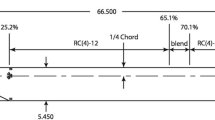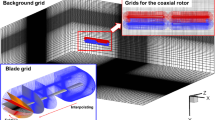Abstract
Numerical simulations of the HVAB were carried out by using a Reynolds-averaged Navier-Stokes computational fluid dynamics flow solver. For the computation, mixed meshes of unstructured/Cartesian grids were used. An improved laminar-turbulent crossflow transition model γ − Reθt − CF+ was used to predict laminar-turbulent transition phenomena. In addition, to achieve high resolute flow solutions, an improved scheme ESWENO-P was employed when calculating inviscid fluxes. To find the turbulence intensity for the simulations, a parametric study was first conducted with the PSP rotor configuration. The influence of the facility walls of the National Full-Scale Aerodynamics Complex was also investigated. Then, the HVAB rotor performance was predicted under conditions obtained by simulations of the PSP rotor. The HVAB rotor performance of the rotor, including thrust/torque coefficients and figure of merit, were analyzed. In addition, flow characteristics, such as laminar-turbulent locations and tip vortex trajectories, were also investigated.
Similar content being viewed by others
Abbreviations
- C T :
-
Thrust coefficient
- C Q :
-
Torque coefficient
- c p :
-
Pressure coefficient
- d :
-
Wall distance vector
- k :
-
Turbulence kinetic energy
- r :
-
Radial distance along the blade span
- r :
-
Reynolds number ratio, crosswise
- R :
-
Rotor blade radius
- Re δ2c :
-
Displacement thickness Reynolds number at transition onset, crosswise (transition criterion)
- Re θt :
-
Momentum thickness Reynolds number at transition onset, streamwise
- S :
-
Strain rate
- γ :
-
Intermittency
- θ :
-
Momentum thickness, streamwise
- λ θ :
-
Pressure gradient parameter
- μ :
-
Molecular viscosity
- μ T :
-
Eddy viscosity
- ρ :
-
Density
- σ :
-
Rotor blade solidity
- φ :
-
Local sweep angle
- ω :
-
Specific turbulence dissipation rate
- Ω :
-
Vorticity magnitude, streamwise
- β k :
-
Smoothness Indicators
- CF :
-
Cross-flow
- ζ k :
-
Fine-tuning term used in ESWENO-P scheme
- f k :
-
Flux at xk
- m :
-
Number of candidate stencils
- α k :
-
Unnormalized nonlinear weights of WENO family schemes
- c k :
-
A set of constants used for computing nonlinear weights
- p :
-
Power parameter used in WENO-Z scheme
- p′ :
-
Power parameter used in ESWENO-P scheme
- ε :
-
Sensitivity parameter used in WENO family schemes
- τ :
-
Global order smoothness indicator
- τ′ :
-
Weight function used in ESWENO scheme
- θ 0 :
-
Collective pitch angle
- c :
-
Reference chord length
- x :
-
Chordwise location
- ZP :
-
User-defined parameter used in WENO-ZP scheme
- ES :
-
User-defined parameter used in ESWENO-P scheme
- CFD :
-
Computational fluid dynamics
- FSC :
-
Falkner-Skan-Cooke
- MPI :
-
Massage passing interface
- PSP :
-
Pressure sensitive paint
- RANS :
-
Reynolds-averaged Navier-Stokes
- FM :
-
Figure of merit
- y + :
-
Non-dimensional distance from the wall to the first mesh node
References
X. D. Liu, S. Osher and T. Chan, Weighted essentially non-oscillatory schemes, Journal of Computational Physics, 115(1) (1994) 200–212.
G. S. Jiang and C. W. Shu, Efficient implementation of weighted ENO schemes, Journal of Computational Physics, 126(1) (1996) 202–228.
A. K. Henrick, T. D. Aslam and J. M. Powers, Mapped weighted essentially non-oscillatory schemes: achieving optimal order near critical points, Journal of Computational Physics, 207(2) (2005) 542–567.
R. Borges, M. Carmona, B. Costa and W. S. Don, An improved weighted essentially non-oscillatory scheme for hyperbolic conservation laws, Journal of Computational Physics, 227(6) (2008) 3191–3211.
N. Yamaleev and M. Carpenter, Higher-order energy stable WENO schemes, 47thAIAA Aerospace Sciences Meeting Including the New Horizons and Aerospace Exposition, Orlando, Florida, USA (2009).
F. Acker, R. Borges and B. Costa, An improved WENO-Z scheme, Journal of Computational Physics, 313 (2016) 726–753.
S. H. Park and O. J. Kwon, Extension of a high-order high-resolution ESWENO-P scheme for vortex/shock problems, 12thAsian Computational Fluid Dynamics Conference, Yilan, Taiwan (2018).
S. H. Park and O. J. Kwon, Numerical study of isolated and full configuration PSP rotor using a mixed mesh flow solver, AIAA SciTech 2020 Forum, Orlando, Florida, USA (2020).
S. H. Park and O. J. Kwon, Assessment of blade-vortex interaction using a high-order high-resolution ESWENO-P scheme, 2021 Asia-Pacific International Symposium on Aerospace Technology, Jeju Island, Korea (2021).
R. B. Langtry and F. R. Menter, Correlation-based transition modeling for unstructured parallelized computational fluid dynamics codes, AIAA Journal, 47(12) (2009) 2894–2906.
S. Medida and J. Baeder, A new crossflow transition onset criterion for RANS turbulence models, 21th AIAA Computational Fluid Dynamics Conference, San Diego, California, USA (2013).
R. Jain, CFD performance and turbulence transition predictions on an installed model-scale rotor in hover, 55thAIAA Aerospace Sciences Meeting, Grapevine, Texas, USA (2017).
J. H. Choi and O. J. Kwon, Enhancement of a correlation-based transition turbulence model for simulating three-dimensional boundary layers, AIAA Journal, 53(10) (2015) 3063–3072.
J. C. Cooke, The boundary layer of a class of infinite yawed cylinders, Mathematical Proceedings of the Cambridge Philosophical Society, 46(4) (1950) 645–648.
J. H. Choi and O. J. Kwon, Recent improvement of a correlation-based transition model for simulating three-dimensional boundary layers, AIAA Journal, 55(6) (2017) 2013–2018.
J. Y. Hwang and O. J. Kwon, Numerical study of PSP rotor blades using a y — γ − Reθι − CF+ turbulent transition model, AIAA Sci Tech 2019 Forum, San Diego, California, USA (2019).
S. H. Park and O. J. Kwon, Numerical study of effects of fuselage and facility wall on PSP rotor performance in hover, International Journal of Aeronautical and Space Sciences (2021) (Online published).
J. S. Han, J. Y. Hwang and O. J. Kwon, Numerical Investigation of effect of crossflow transition on rotor blade performance in hover, Aerospace Science and Technology, 114 (106733) (2021).
P. L. Roe, Approximate Riemann solvers, parameter vectors and difference, Journal of Computational Physics, 43(2) (1981) 357–372.
S. R. Mathur and J. Y. Murthy, A pressure-based method for unstructured meshes, Numerical Heat Transfer, 31(2) (1997) 195–215.
V. Venkatakrishnan, Convergence to steady state solutions of the Euler equations on unstructured grids with limiters, Journal of Computational Physics, 118(1) (1995) 120–130.
G. Karypis and V. Kumar, Multilevel k-way partitioning schemes for irregular graphs, Journal of Parallel and Distributed Computation, 48(1) (1998) 96–129.
A. Overmeyer and P. Martin, Measured boundary layer transition and rotor hover performance at model scale, 55thAIAA Aerospace Sciences Meetings, Grapevine, Texas, USA (2017).
R. Jain, Effect of facility walls and blade aeroelasticity on PSP rotor hover performance predictions, 2018 AIAA Aerospace Sciences Meeting, Kissimmee, Florida, USA (2018).
R. Narducci, R. Jain, J. Abras and N. Hariharan, HVAB rotor hover computational prediction: a comparative study using OVERFLOW and HPCMP CREATETM-AV helios, AIAA SciTech 2021 Forum (2021) (Virtual event).
Acknowledgments
This work was conducted at High-Speed Compound Unmanned Rotorcraft (HCUR) research laboratory with the support of Agency for Defense Development (ADD).
Author information
Authors and Affiliations
Corresponding author
Additional information
Sang Hyun Park is a Ph.D. student at the Computational Aerodynamics and Design Optimization Laboratory in the Department of Aerospace Engineering, KAIST, Korea. His research interests are in numerical schemes and rotor aerodynamics.
Oh Joon Kwon is a Professor in the Department of Aerospace Engineering, KAIST, Korea. His research interests are in CFD based on unstructured mesh technique, design optimization, and rotor aerodynamics.
Rights and permissions
About this article
Cite this article
Park, S.H., Kwon, O.J. Numerical simulation of HVAB rotor in hover using a mixed-mesh flow solver. J Mech Sci Technol 36, 2969–2979 (2022). https://doi.org/10.1007/s12206-022-0529-4
Received:
Revised:
Accepted:
Published:
Issue Date:
DOI: https://doi.org/10.1007/s12206-022-0529-4




